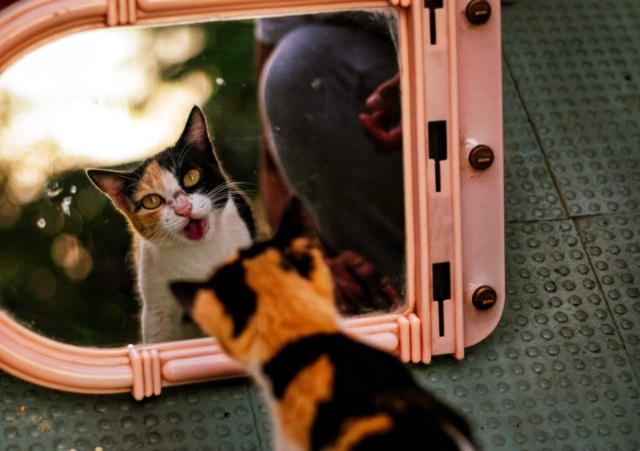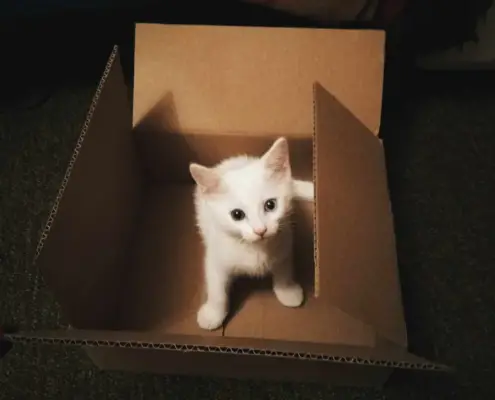
Cats have long been known for their curious nature. They are fascinated by the world around them and often find themselves engrossed in their own reflections. As cat owners, we have all witnessed our feline friends pawing at mirrors or staring intently at their own images. This raises the question: can cats see their reflection in a mirror? Do they recognize themselves? In this article, we will delve into the intriguing world of feline behavior and explore whether cats truly possess the ability to recognize themselves in mirrors.
Can cats see their reflection?
To answer this question, it is important to understand how the feline visual system works. Cats, like humans, possess binocular vision, allowing them to see objects in three dimensions. However, their visual acuity is not as sharp as ours, and they primarily rely on their other senses, such as hearing and scent, to navigate their surroundings. When it comes to mirrors, cats are able to perceive their own reflection as an object, but whether they can identify it as their own image is still up for debate.
The mirror test for self-recognition
The mirror test, often used to determine self-recognition in animals, involves placing a mark on an individual’s body that can only be seen in a mirror reflection. If the individual recognizes the mark as being on their own body, it is considered an indication of self-awareness. This test has been conducted on various animal species, such as primates and dolphins, with mixed results. However, when it comes to cats, the mirror test has not conclusively proven their ability to recognize themselves.
Understanding how cats perceive mirrors
To comprehend why cats may not recognize themselves in mirrors, we must delve into their perception of the world. Cats, unlike humans, do not possess a strong sense of self-identity. They are not concerned with their own appearance or the concept of self-image. Their focus is primarily on survival and their immediate environment. When a cat sees its reflection in a mirror, it may perceive it as another individual or as a potential threat, rather than recognizing it as themselves.
Signs that cats recognize themselves in mirrors
While cats may not possess the same level of self-awareness as humans, there are certain signs that indicate they may indeed recognize themselves in mirrors. One of the most common behaviors is when a cat interacts with its reflection, rather than simply observing it. If a cat engages in play behavior, such as pouncing or batting at its reflection, it could be an indication that it recognizes the image as its own. Additionally, cats may also display signs of familiarity, such as rubbing their face against the mirror or purring while looking at their reflection.
Factors that may affect a cat’s reaction to their reflection
It is important to note that a cat’s reaction to its reflection can vary based on several factors. The individual cat’s personality, previous experiences, and age can all influence its response to mirrors. Some cats may be more curious and playful, while others may be more skittish or indifferent. Additionally, the introduction of a mirror at a young age may increase the likelihood of a cat recognizing itself, as it becomes a familiar part of their environment. It is crucial to observe your cat’s behavior and tailor the introduction of a mirror accordingly.
Can cats become obsessed with their reflection?
While it is rare, some cats may develop an unhealthy fascination with their reflection. This can manifest as excessive aggression or anxiety when confronted with a mirror. If you notice such behavior in your cat, it is important to consult with a veterinarian or animal behaviorist for guidance. They can help determine the underlying cause and provide appropriate solutions to address the issue.
How to introduce a mirror to your cat
If you wish to introduce a mirror to your cat, it is important to do so gradually and in a controlled manner. Start by placing a small, unbreakable mirror in an area where your cat frequently spends time. Observe their reaction from a distance and ensure they feel safe and comfortable. If your cat shows positive interest, you can slowly move the mirror closer or provide interactive toys that incorporate mirrors to engage their curiosity further.
Fun ways to engage your cat with mirrors
Mirrors can be a source of entertainment and mental stimulation for your cat. Consider incorporating interactive toys that feature mirrors into their playtime routine. These toys can encourage your cat to engage with their reflection and provide them with an enriching and enjoyable experience. Additionally, you can also create a designated play area with mirrors, cat-friendly obstacles, and toys to further stimulate their curiosity and keep them physically active.
Conclusion
While the ability of cats to recognize themselves in mirrors remains a topic of scientific debate, it is clear that they do possess a level of curiosity and interest in their own reflections. Whether your cat engages in playful behavior or simply observes its reflection, mirrors can provide a source of entertainment and mental stimulation for these curious creatures. By understanding how cats perceive mirrors and tailoring the introduction of mirrors to their individual personalities, we can provide them with a safe and enjoyable experience. So go ahead, embrace the curiosity of your feline friend and let them explore the world of mirrors.
If you enjoyed my article, I would appreciate you sharing it with your network.

Sima Ndlebe
Sima writes for CatBuzz. He is interested in Cats, Health and Fitness, and Entrepreneurship.
Published: 1 November 2023



